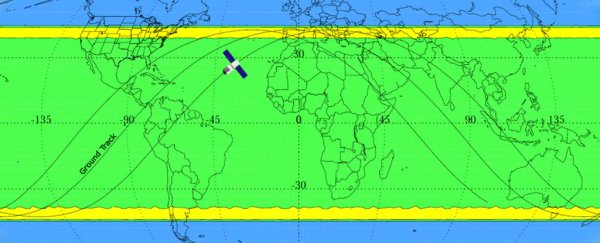Heads up, Spain and Portugal. And France. Maybe you too, Greece.
China's 9.5 ton (8.6 tonne) space station, Tiangong-1, will come falling from space soon, and it's predicted to head in that general direction.
For the uninitiated, Tiangong-1 launched in 2011 as China's first space laboratory, a prototype for what the country hoped would eventually be a permanent space station.
For about five years, it did just that, orbiting Earth and acting as a base for three missions (two manned, one unmanned) for the Chinese National Space Administration.
In September 2016, however, Chinese officials announced that they had lost control of the station, meaning Tiangong-1 (literally "heavenly palace") would eventually defy its name and come hurtling back to Earth.
Exactly when or where it would do so was a mystery.
At first, Chinese scientists ventured that the "uncontrolled reentry" would take place sometime in the latter half of 2017. That window was later pushed back to sometime between October 2017 and April 2018.
In January, the California-based nonprofit Aerospace Corp. predicted that Tiangong-1 would reenter in mid-March, give or take two weeks.
This week, the European Space Agency (ESA) gave a more specific time frame - between March 29 and April 9 - and narrowed the reentry locations to "anywhere between 43 degrees N and 43 degrees S (e.g. Spain, France, Portugal, Greece, etc.)".
It is worth noting that the new predictions come with enough caveats (see: "etc.") to make a cable appointment seem exacting. The current estimated window is "highly variable," the European Space Agency cautioned.
Areas outside the given latitudes could be excluded - but the forecast is still being updated weekly, it added.
"At no time will a precise time/location prediction from ESA be possible," the agency said. Popular Mechanics notes that, given the station's path of orbit, it could also reenter the atmosphere in the Southern Hemisphere near 43 degrees latitude.
"Parts of the United States, the Iberian Peninsula, China, the Middle East, South America, Australia, and New Zealand are all potential reentry locations," the magazine reported.
Still, there are several reasons not to panic. First and foremost, much, if not all, of the roughly 19,000 pound (8618 kilogram) laboratory is expected to disintegrate upon reentry.
"In the history of spaceflight, no known person has ever been harmed by reentering space debris," the Aerospace Corp. stated in January. "Only one person has ever been recorded as being hit by a piece of space debris and, fortunately, she was not injured."
The nonprofit included the map (above) that illustrated zones where Tiangong-1 could fall, noting that even for people in the "worst-case location" (the yellow region), the chances of being struck by debris are "about one million times smaller than the odds of winning the Powerball jackpot."
But Jonathan McDowell, an astrophysicist from Harvard University, told The Guardian that pieces weighing up to 220 pounds could make it to Earth's surface.
Even slight changes in atmospheric conditions can alter the landing site "from one continent to the next," McDowell told the newspaper.
"You really can't steer these things," he said.
"Even a couple of days before it reenters, we probably won't know better than six or seven hours, plus or minus, when it's going to come down. Not knowing when it's going to come down translates as not knowing where it's going to come down."
2018 © The Washington Post
This article was originally published by The Washington Post.
